
| 1,300k University Park from space The Meteorology Department occupies the top few floors of the Walker Building. This is view of the Walker Building (left side of image) from space was captured on the morning of April 15, 1994, by the USGS (United State Geological Survey). If you click on the image to the left, the resulting QTVR will enable you to navigate around the University Park campus and portions of the business regions of the adjoining community of State College. |

| 890k Walker Building entrance The Walker Building houses the Meteorology Department, but the entrance to it is very quiet on this late Sunday afternoon in the Fall. |
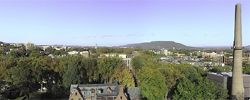
| 770k Walker Building environs The Walker building is one of the taller buildings on the University Park campus and so offers a good view of the University and surrounding territory. view. |
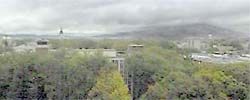
| 380k Walker Building environs (rain) This panorama was taken from the top of the Walker Building on a wet day (Sept. 09, 1998). While most promotional literature insits on showing scenes on sunny days, meteorologists have a different view about what might be interesting. We take great delight in skyscapes both with and without clouds. Besides, clouds bring such fascinating things as rain, hail, snow, lightning and tornados. How could we not enjoy them? Of course, you may also look at the landscape below the horizon. |
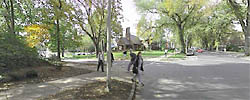
| 890k Burrowes Road The Meteorology Department is in the College of Earth and Mineral Sciences. Running right through the College is Burrows Road along which stands one of the finest rows of Dutch Elm trees in easter United States. The Walker Building, in which the Department is located, is seen through the trees (below the label on the thumbnail image) about a block from Burrowes. |

| 420k Nittany Lion shrine A Nittany Lion is the mascot of Penn State University and is featured extensively on its symbols and memorabelia. This shrine to the the Nittany Lion is located at the north end of Burrowes Road between Rec Hall and the Kern Building. |
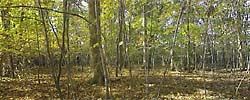
| 1,200k Path through woods This is view along a path through the woods on the side of Mount Nittany (a favorite hiking spot for students). The fall follage is greatly in evidence. The leaves begin to loose their green pigments as the days get shorter, and then they fall (thus, the name of the season) as the temperature begins to drop. Image captured Sept. 10, 1998. |

| 260k Campbell-Stokes sunshine recorder Such instruments served for over a century as the primary way to record the number of hours of sunshine for a site. Whenever you see climatological information on the average number of hours of sunshine a day (such as is often presented in tourist literature), the likelihood is that the information is collected with such and instrument. When the Sun is out, the spherical lens burns a trace on a piece of special paper; the length of the trace reveals the number of hours of sunlight. |
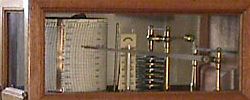
| 230k Aneroid barograph The aneroid barograph [baro: weight or pressure; graph: to write or draw; aneroid: without liquid] is a device long used to record the varying atmospheric pressure. Changes in the air pressure cause the accordion-like chamber to expand or contract and this motion is transferred through levers to a pen which records the value on a chart driven by clockworks. |
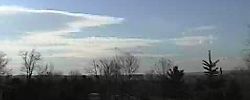
| 1000k Wave clouds Penn State University lies in a broad valley with ridges to the north and south rising about a thousand feet above the valley floor . Often, as the air which flows over these ridges forms waves on the lee side, in a manner similar to that of water flowing over a rock in a creek. Clouds form at the crest of these waves where the air is coolest. What is striking about these wave clouds, is that they stay in one place as the air flows through them. This is apparent in this time-lapse view where the wave clouds grow and shrink, and elements move through them, but there is little movement of the cloud itself. |

| 2,500k Hurricane This is a view of Hurricane Erin (1996). This was created from two satellite images: the infrared image was used to provide information on the height of the top of the clouds, and the visible was used to provide information on the brightness of the scene. |

| 750k And finally, for the terminally perverse, here is a really virtual QuickTimeVR showing the perpetrator of this page standing in a mirrored elevator. |


